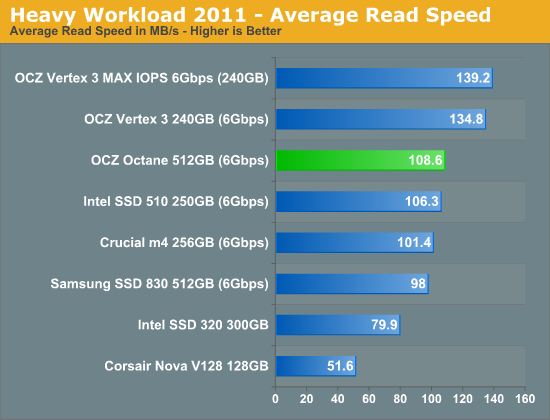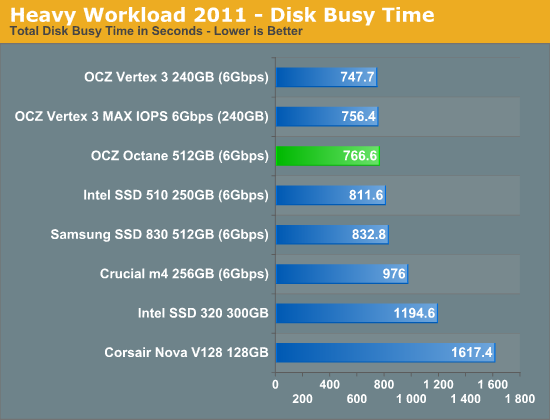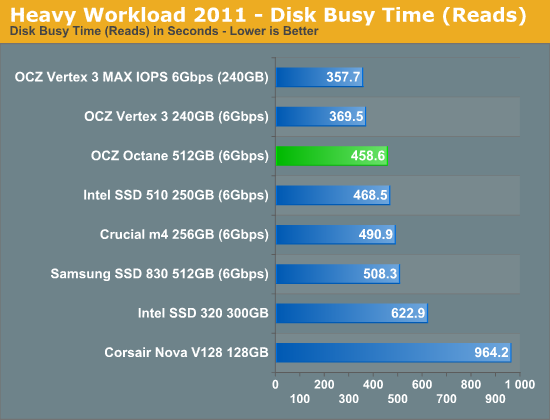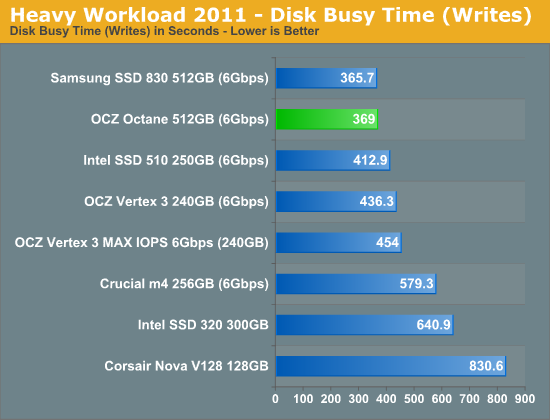The OCZ Octane Review (512GB)
by Anand Lal Shimpi on November 23, 2011 12:00 PM ESTAnandTech Storage Bench 2011
Last year we introduced our AnandTech Storage Bench, a suite of benchmarks that took traces of real OS/application usage and played them back in a repeatable manner. I assembled the traces myself out of frustration with the majority of what we have today in terms of SSD benchmarks.
Although the AnandTech Storage Bench tests did a good job of characterizing SSD performance, they weren't stressful enough. All of the tests performed less than 10GB of reads/writes and typically involved only 4GB of writes specifically. That's not even enough exceed the spare area on most SSDs. Most canned SSD benchmarks don't even come close to writing a single gigabyte of data, but that doesn't mean that simply writing 4GB is acceptable.
Originally I kept the benchmarks short enough that they wouldn't be a burden to run (~30 minutes) but long enough that they were representative of what a power user might do with their system.
Not too long ago I tweeted that I had created what I referred to as the Mother of All SSD Benchmarks (MOASB). Rather than only writing 4GB of data to the drive, this benchmark writes 106.32GB. It's the load you'd put on a drive after nearly two weeks of constant usage. And it takes a *long* time to run.
1) The MOASB, officially called AnandTech Storage Bench 2011 - Heavy Workload, mainly focuses on the times when your I/O activity is the highest. There is a lot of downloading and application installing that happens during the course of this test. My thinking was that it's during application installs, file copies, downloading and multitasking with all of this that you can really notice performance differences between drives.
2) I tried to cover as many bases as possible with the software I incorporated into this test. There's a lot of photo editing in Photoshop, HTML editing in Dreamweaver, web browsing, game playing/level loading (Starcraft II & WoW are both a part of the test) as well as general use stuff (application installing, virus scanning). I included a large amount of email downloading, document creation and editing as well. To top it all off I even use Visual Studio 2008 to build Chromium during the test.
The test has 2,168,893 read operations and 1,783,447 write operations. The IO breakdown is as follows:
| AnandTech Storage Bench 2011 - Heavy Workload IO Breakdown | ||||
| IO Size | % of Total | |||
| 4KB | 28% | |||
| 16KB | 10% | |||
| 32KB | 10% | |||
| 64KB | 4% | |||
Only 42% of all operations are sequential, the rest range from pseudo to fully random (with most falling in the pseudo-random category). Average queue depth is 4.625 IOs, with 59% of operations taking place in an IO queue of 1.
Many of you have asked for a better way to really characterize performance. Simply looking at IOPS doesn't really say much. As a result I'm going to be presenting Storage Bench 2011 data in a slightly different way. We'll have performance represented as Average MB/s, with higher numbers being better. At the same time I'll be reporting how long the SSD was busy while running this test. These disk busy graphs will show you exactly how much time was shaved off by using a faster drive vs. a slower one during the course of this test. Finally, I will also break out performance into reads, writes and combined. The reason I do this is to help balance out the fact that this test is unusually write intensive, which can often hide the benefits of a drive with good read performance.
There's also a new light workload for 2011. This is a far more reasonable, typical every day use case benchmark. Lots of web browsing, photo editing (but with a greater focus on photo consumption), video playback as well as some application installs and gaming. This test isn't nearly as write intensive as the MOASB but it's still multiple times more write intensive than what we were running last year.
As always I don't believe that these two benchmarks alone are enough to characterize the performance of a drive, but hopefully along with the rest of our tests they will help provide a better idea.
The testbed for Storage Bench 2011 has changed as well. We're now using a Sandy Bridge platform with full 6Gbps support for these tests.
AnandTech Storage Bench 2011 - Heavy Workload
We'll start out by looking at average data rate throughout our new heavy workload test:

When put to the test the Octane does not disappoint. It's within a couple MB/s of the SF-2281 based Vertex 3, and effectively one of the fastest 6Gbps drives on the market today. I included the old Indilinx Barefoot based Corsair Nova V128 to show just how far Indilinx has come here.


The next three charts just represent the same data, but in a different manner. Instead of looking at average data rate, we're looking at how long the disk was busy for during this entire test. Note that disk busy time excludes any and all idles, this is just how long the SSD was busy doing something:













75 Comments
View All Comments
Taft12 - Wednesday, November 23, 2011 - link
Anand, do you have any insight into how the SSD industry's volume breakdown goes WRT size?I would be shocked if drives > 128GB made up more than 5% of shipments of consumer-class SSDs. I realize that hardware vendors want their product seen in the best possible light, but this 512GB drive might move a couple thousand units total globally whereas the 128GB version might see a couple orders of magnitude more.
Sunrise089 - Thursday, November 24, 2011 - link
I echo both the request-for-info-on/suspicion of the breakdown in shipments between 128gb models and 512gb models. I also very much echo the desire for more reviews of 128gb drives.I get this is what you get sent, but one of the reasons I love Anandtech is that you guys will actually play hardball with the manufacturers. I'm not telling you to refuse to review 512/256gb drives unless you're sent a 128gb model too, but at the same time I doubt you'd only review Extreme Edition CPUs or dual-GPU video cards.
niva - Wednesday, November 23, 2011 - link
Thanks a bunch Anand, it's amazing how the perception for OCZ has changed, I remember the days when it was a "stay away from" company. Personally I still haven't bought an OCZ product after getting stuck with dead RAM modules (one outright, one with errors) years ago and having no recourse.Still, competition is good, and OCZ has done a lot to bring prices down for SSDs. Hope they succeed in the long term. I was also really tentative about the Indilux acquisition, but so far it's a definite success.
james.jwb - Wednesday, November 23, 2011 - link
pretty much all the OCZ memory modules i had over time died prematurely. Bad luck i guess.inighthawki - Wednesday, November 23, 2011 - link
I own 4 1GB modules that are a good 5+ years old, all still work fine.PubFiction - Saturday, November 26, 2011 - link
Well I do not know how much it has changed overall I would say I still have a negative view of OCZ. They just seem to be a decent marketing machine but they put out alot of garbage. They constantly have sales on bad products which people jump on to try and then get burned. Right now and for months their SSDs which have reliability and firm ware issues are all going on sale for hard to resist prices. I had ram from them that while it still works had a sticker that was so thick it had to be removed in order to fit in the slots. Of course that was on sale too which is why I tried it. Instead of really fixing problems or avoiding them they tend to just drop prices and sell more of it. We also just went through the whole different slower nand on the same part fiasco.inighthawki - Wednesday, November 23, 2011 - link
Ah, ok. As someone looking into buying a new SSD soon, I sure would like to see how the 128GB version pairs up vs other SSDs in the same range. Hopefully you will extend the review at some point if you get different models :PDigitalFreak - Wednesday, November 23, 2011 - link
I wonder about that also. Seems like all the review sites got the 512GB model.hackztor - Wednesday, November 23, 2011 - link
hum, still seem to like the vertex 3 better. This could be good, but the other day newegg had a nice sale for the vertex 3 120gb max iops for 150. Really cannot beat that. I think the key though is benchmarks are getting overrated because these drives are so fast especially compared to hard drives. They need to have a reliability chart, that would be lol. I know I went through 4 vertex 1 drives before ocz upgraded me to vertex 2 so I am somewhat hesitant.mckirkus - Wednesday, November 23, 2011 - link
Given that the vast majority of people (according to top sellers at NewEgg) buy drives in the 60 to 128 GB range, it seems odd that they're rarely represented in benchmarks. It'd be interesting to know what percentage of their sales are 512GB drives.